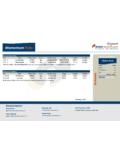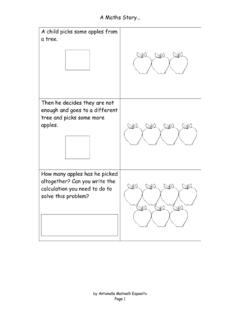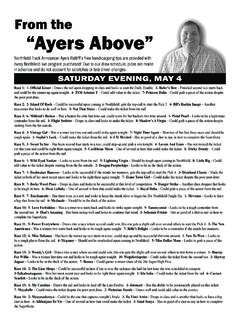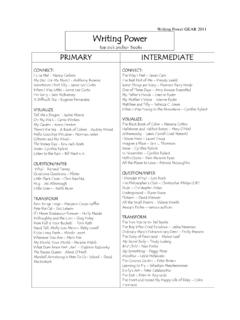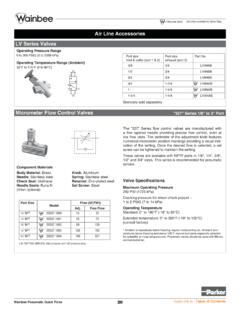Transcription of ON THE VALUE OF AFL PLAYER DRAFT PICKS - Ranking …
1 Preprint submitted to MATHSPORT 2010 October 15, 2010 ON THE VALUE OF AFL PLAYER DRAFT PICKS Darren O Shaughnessy a a Ranking Software: Abstract AFL (Australian Football League) clubs are allocated PLAYER selections ( PICKS ) in the National DRAFT in reverse order of their final position in the preceding season. Clubs which perform below a certain threshold in a single season are allocated an additional pick , while clubs which meet that threshold in two successive seasons receive a more valuable pick . These somewhat arbitrary thresholds lead to a discontinuous performance / reward relationship, where it is clearly in a club s best interest to lose certain matches. The natural suspicion and speculation around tanking detracts from the integrity of the game, in the eyes of the AFL.
2 However, a recent paper by Borland, Chicu & Macdonald (2009) concludes that there is little evidence of systematic losing to win in that league. A natural and flexible valuation scheme for DRAFT PICKS is proposed and tested, using extreme VALUE statistics pioneered by Gumbel (1954) in what could be regarded as a variation on Galton (1902) s Difference Problem. It removes the arbitrary discontinuities while continuing to support competitive equalisation via higher PICKS for genuinely struggling clubs. This DRAFT pick method does not enforce a constant order to be followed in every round. As a corollary, the scheme suggests a method for clubs to VALUE their PICKS when developing trading strategies.
3 It could also furnish the AFL with an alternative means of compensating clubs for the loss of key players to start-up teams, and penalising clubs for transgressions. While this scheme has direct applicability to the AFL, it is easily portable to other sports PLAYER drafts, such as the NFL, MLB and NBA. Keywords: Australian Rules Football, AFL, PLAYER DRAFT , Extreme VALUE Theory, Galton s Difference Problem 2 1. INTRODUCTION The Australian Football League (AFL) s annual National DRAFT is the only way for existing clubs to add players to their squads1, and is therefore crucially important to their prospects. In common with many other sports, as part of its competition equalisation policy the AFL allocates DRAFT PICKS in order of reversed final position on the ladder (AFL Development, 2010).
4 More controversially (see Sheahan (2009)), clubs are allocated priority PICKS if they are considered to be direly uncompetitive. A team which fails to win more than four matches is given an extra pick between the first and second rounds of the DRAFT , while a team falling below this threshold in two consecutive seasons has its priority pick upgraded to above the first round. In this way Melbourne Football Club received both of the first two DRAFT PICKS in the 2009 DRAFT after finishing last with exactly four wins in the second of its dire seasons. Certainly the reward for Melbourne losing just its last game was immense: access to the two best players in the country, rather than one.
5 With the addition of new clubs over the next two years, the AFL has proposed a formula to compensate existing clubs for the loss of star players. Wilson (2010) suggests that for the very best players, the AFL may provide two first-round PICKS instead of one, with the club able to choose which year it exercises the extra PICKS , but only after its existing first-round pick (the position of which will vary from year to year). For a club in this situation, there is a great deal riding on the AFL s decision, and the quantum of compensation is rather large they cannot have first-round PICKS , for instance. In this paper I develop a valuation system for DRAFT PICKS and advise how the arbitrary thresholds in the system might be abolished without losing the ability to help truly uncompetitive teams.
6 AFL DRAFT Research Borland, Chicu & Macdonald (2009) examined the teams faced by these perverse incentives for deliberately losing (also known as tanking ) and concluded that there is no significant change in behaviour. A dreadful season can lead to loss of sponsors and members, and fewer lucrative TV slots when the fixture is drawn up. Rielly (2009) reported on commissioned research by Mitchell et al (2009) that found good correlation between DRAFT order and subsequent PLAYER performance for the first round 1 PLAYER trading is only permitted within the framework of the DRAFT , and usually in exchange for DRAFT PICKS only, with very weak correlation after pick number 16.
7 Bedford & Schembri (2006) proposed a system where clubs not in contention for finals are rewarded for winning formally unimportant matches with an improved DRAFT position. Other Leagues DRAFT Research Professional US leagues such as the NFL, NBA and MLB have similar annual drafts. Burger & Walters (2009) point out that there is high risk and a lot of money at stake: only 8% of players picked in the first ten rounds of the MLB DRAFT become established Major League players. Barzilai (2007) thoroughly analyses the empirical VALUE of NBA DRAFT pick players. Berri & Simmons (2009) give an example of teams not using their choices wisely, with only a weak correlation between NFL amateur DRAFT order and performance.
8 Massey & Thaler (2005) state that NFL clubs overvalue the right to choose, and pay too much for the first pick in the DRAFT . The NFL DRAFT appears to receive the most attention, likely due to a famous DRAFT VALUE Chart developed around 1990 (Trotter, 2007) under Dallas Cowboys head coach Jimmy Johnson, anecdotally (Crowe, 2009) with help from mathematicians although the exact derivation is unknown. The chart gives a rule-of-thumb VALUE that clubs should place on their DRAFT PICKS when they are considering trading, so for instance the 1st pick is worth 3,000 points, 2nd pick 2,600, 16th pick 1,000, etc., down to the 224th pick worth 2 points. Recently there have been a number of comprehensive analyses assessing and adjusting this chart ( Stuart (2008), Patterson (2009), Vance (2009)), based on performance ratings of the players picked at those positions, but none presenting an underlying theoretical model.
9 Extreme VALUE Theory Francis Galton (1902) asked the question: if a competition has a 100 pool and there will be prizes for first and second, How should the 100 be most suitably divided between the two? His answer of roughly 75 : 25 is based on the expected VALUE of the excess merit of someone in those positions, compared to the third-place competitor. Subsequent extensions to n prize-winners in large pools of competitors grew into a branch of Extreme VALUE Statistics, pioneered by Gumbel (1935) and Fisher & Tippett (1928). I draw a parallel to the competition between potential draftees. The potential talent pool consists of young men with diverse aptitude for football. In a demographic sense, it is reasonable that an aptitude score for the population cohort of 18-year-old Australian men should be approximately normally 3 distributed2, like many other broad-based attributes.
10 The players drafted would then form one extreme tail of that distribution, assuming that clubs can make an efficient assessment of that aptitude. I propose a system in which the kth DRAFT pick has a VALUE proportional to the kth order statistic of a suitably large normal population. This paper shows the necessary calibrations and consequences. 2. METHODS Galton s method of allocating prizes considered firstly a population of n=10. His simple assumption was that the most probable values of merit for the ten competitors correspond to equidistant values of the cumulative distribution function (CDF), namely , , , , , , , , , By looking up numerical probability integral tables, he discovered that the ratio of first s advantage over third compared to second s advantage over third was about As he increased n, the ratio approached a limit of about Therefore his proposal was that the most appropriate prize for first is about 75% of the pool.
